8.0
Safety, value and features
It’s time to put the MY22 Mazda CX-30 to the test, focusing on the low- to mid-spec Evolve Hybrid to see how the lower end of the CX-30 spectrum compares to the similarly (but not electrified in any way) G20 Evolve, G25 Touring and X20 Astina we reviewed last year.
Half of the range is referred to as G20 to denote the use of a 2.0-litre engine, while the other half is dubbed G25 for the 2.5-litre.
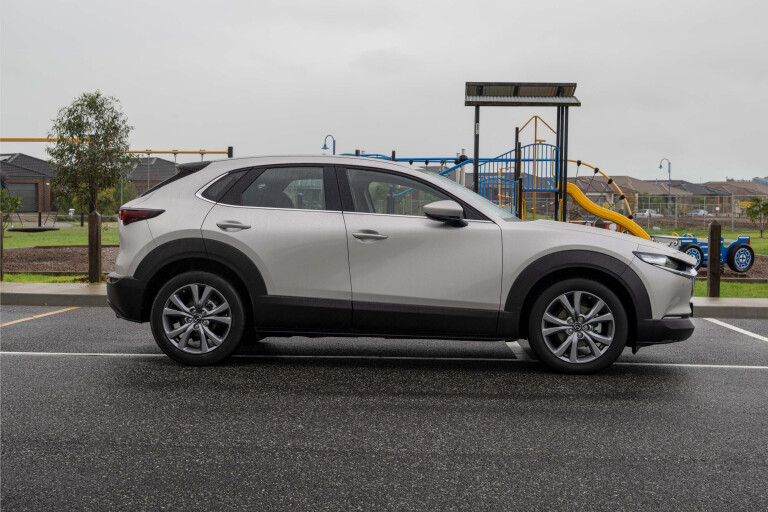
194
The G20 line-up starts with the Pure, before moving up to the regular Evolve, Evolve M Hybrid, Touring, Touring SP and tops off with the Astina while the G25 range begins with the Touring, followed by the Touring SP and is rounded out by the Astina.
Beyond that, throughout the range are added ‘Vision Technology’ variants on all grades except the Astina, which instead gains the flagship X20 Astina that sports Mazda’s new Skyactiv-X engine.

194
Pricing and features
Of the 10 grades available, the car we have on test here is the 2022 Mazda CX-30 G20e Evolve – the third rung on the CX-30 ladder – costing $36,040 RRP, or $36,237 as tested with the addition of $197 carpet floor mats (before on-road costs).
Pricing for the range starts at $29,390 for the base-spec G20 Pure in manual guise, or add $1000 for auto, and goes all the way up $47,390 for the top grade X20 Astina – all before on-road costs.
As standard, the CX-30 G20e Evolve gets features such as automatic LED headlights and tail-lights, dual-zone climate control with rear air vents, 12-volt power outlet, two USB ports for the front, leather-trimmed steering wheel and gear shifter, head-up display, 10-way electric driver’s seat adjustment, eight-speaker audio system, satellite navigation, DAB+ digital radio, keyless entry and start, Bluetooth and multi-function voice control accessible from the steering wheel.
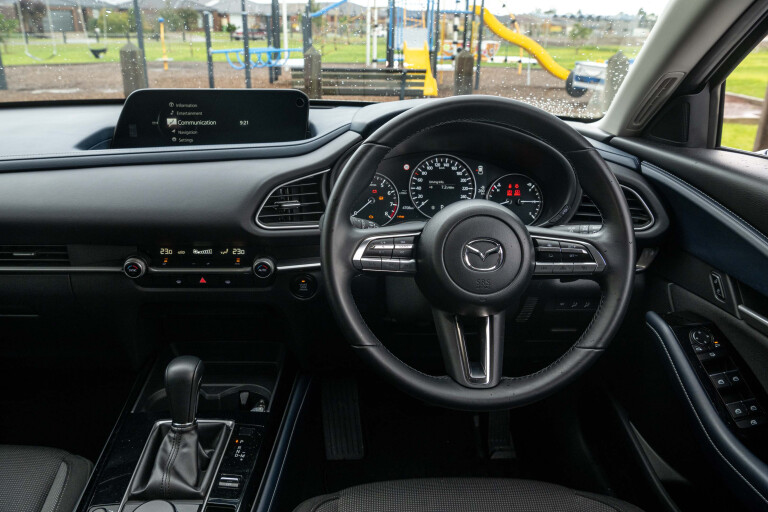
194
This variant sadly misses out on LED daytime running lights, leather seats (available in the next grade up, the G20 Touring) and the heated front seats, Bose 12-speaker sound system and the heated steering wheel available on the G20 Astina.
Even at the top of the range, however, when chosen with either the 2.0-litre or 2.5-litre engine, the Astina still does not get powered seat adjustment for the front passenger, nor do rear occupants gain any USB ports whatsoever – an interesting omission for a premium contender since both its Kia Seltos and Honda HR-V rivals both offer it on their top-spec grades for less money.
On the outside, the CX-30 isn’t much to write home about, with no whacky design features screaming for attention, nothing really breaking the mould and the standard Platinum Quartz metallic paint isn’t exactly sexy.

194
However, it is just classy and simple and manages to look different enough to what is essentially a jacked-up Mazda 3 in crossover form. The plastic wheel-arches could be slimmer, or gone altogether ideally, but it doesn’t detract from what is overall an aesthetically pleasing form.
The interior of the G20e Evolve also feels very premium – even for a low-spec variant. It has a black cloth interior, which looks and feels of high quality even if it’s not leather, and the door and dash materials are similarly high-end. The blue leather-look dash top contrasts well with the black fabric and toned-down hard plastic.
Small chrome details, such as on the door handles and steering wheel – alongside contrast stitching on the seats, dash and central storage bin – make for a beautifully simplistic cabin that is neither bare nor fussy.
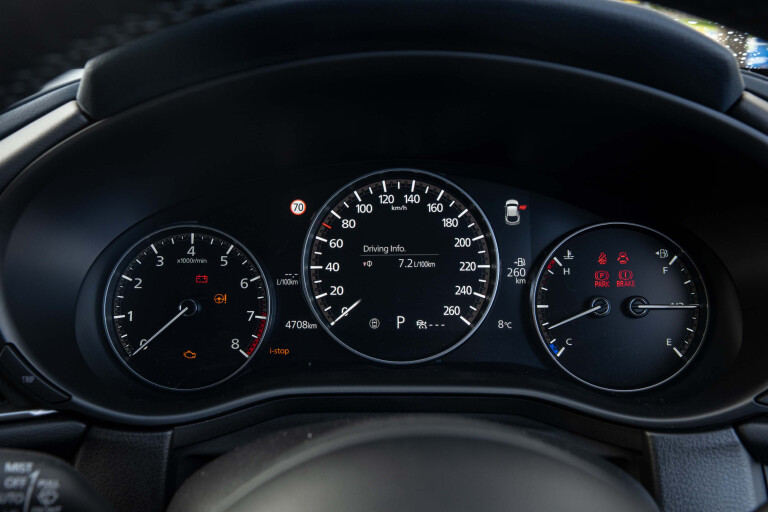
194
The simplicity extends to the climate controls too – just an up/down for temperature and two dials for fan speed displayed via a slim digital screen – which adds to the minimalist vibe.
At the centre of it all is an 8.8-inch infotainment screen, which is easy enough to navigate (even if it does just look like a giant sideways phone) and – in a wild departure from the direction most of the industry is going – is accessible through a rotary dial on the centre console rather than being a touchscreen.
While this may lose points with some, we can honestly say we didn’t miss the ability to paw the display with our mitts – there weren’t any occasions we found that it slowed us down or got on our nerves. And the bonus is, as an owner, precious seconds of your life will be saved by not needing to clean fingerprints off it all the time.
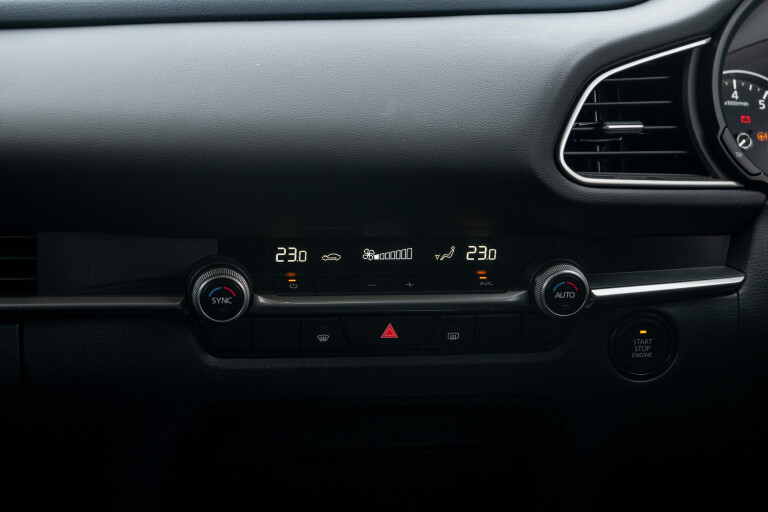
194
The unit’s placement, however, leaves something to be desired – it’s strangely set back so the bottom gets obscured by part of the dashboard and you lose some visibility if you’re not particularly tall or your seating position isn’t high enough.
Additionally, it offers only wired access to Apple CarPlay/Android Auto and lacks wireless charging.
One other missing feature that niggled us a little was the lack of a powered tailgate. Sure, first-world problems and all that – but rather than just leave it off, Mazda has instead lobbed in a lock button in its place, which somehow just irked us more as it is an extra step to take to make sure the car auto locks when you walk away.
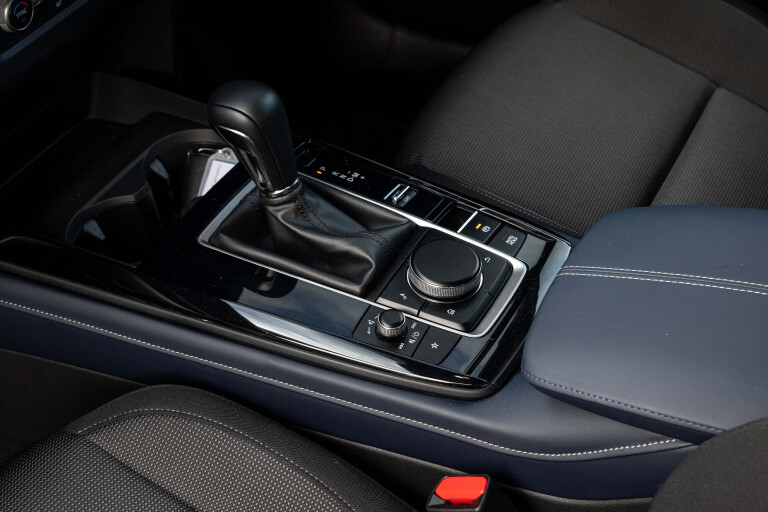
194
If you don’t press it when you shut the boot, you’ll need to make sure you hit the lock button on the key when you really do intend to leave the vehicle – otherwise, the car will be left unlocked. Possibly a well-intentioned addition, but in reality it just added to our ever-growing to-do list.
The Mazda CX-30 was awarded a five-star ANCAP rating in 2019, and as standard benefits from safety features such as 360-degree cameras, a reverse camera (providing one of the clearest images out there), seven airbags, blind-spot monitoring, two Isofix anchors and three top tether points, child-proof rear door locks, driver attention alert and driver monitoring, emergency brake assist, front and rear cross-traffic alert, hill launch assist, intelligent speed assist, lane departure warning, lane-keep assist, front and rear parking sensors, smart brake support and traffic sign recognition.
Beyond the standard features, buyers can choose from five free paint options (our test car wore one of these, known as Platinum Quartz metallic), as well as three cost options – Polymetal Grey, Soul Red Crystal and Machine Grey (all metallic) – for $595.
The G20e Evolve rides on 18-inch metallic grey alloys as standard, but upgrading to a sporty-looking silver wheel design costs $2024 or classy satin chrome rims will set you back an added $2104.
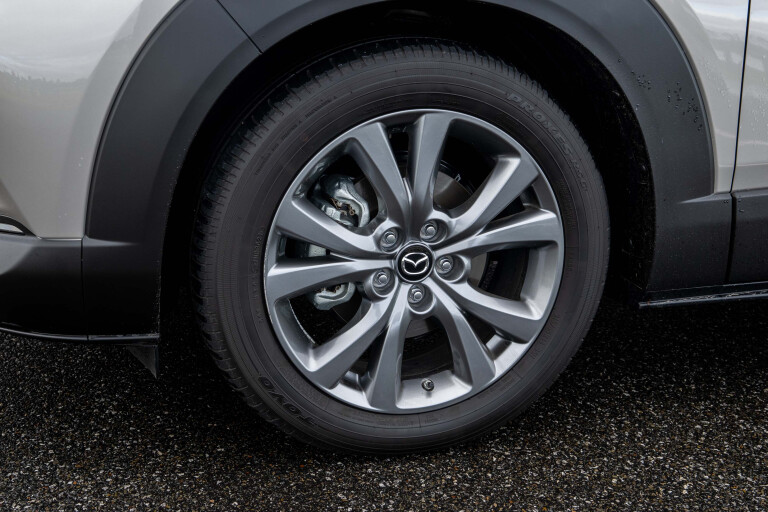
194
Comfort and space
Only the driver gets a power-adjusted seat in the CX-30 – though having 10 different options to twiddle, as well as more-than-adequate cushioning, makes for one very comfortable chair. It also has two memory positions so you never have to fear someone else coming in and ruining your entire set-up. On the flip side, however, the headrests are rock hard.
In the front row, there’s plenty of storage for basic needs, with two cup holders plus slots in the doors for slim drink bottles, a deep central bin and a drop-down sunglasses compartment in the ceiling.
However, one small design quirk lies in the space allocated to putting your phone – it’s not wide enough to accommodate a standard size iPhone (think 10/11) let alone larger models (such as a 13 Pro Max), which feels like something a manufacturer with premium aspirations should be getting right.

194
The further back you go, the more restricted space becomes, with second-row passengers wedged in fairly tightly. Sitting in the back, we found we only had around 10 centimetres between us and the seat in front – and that’s being a female of average height, meaning anyone taller could struggle to squeeze themselves in or feel cramped if they did.
Even our three-year-old had his legs pushing up against the back of the front passenger seat when extended, not leaving much room for growth – and that was with said seat pulled almost all the way forward. Headroom too could be an issue for taller folk, as could getting in and out of the rear doors, which was slightly awkward for us already due to the shape of the exit.
While back seat passengers get two cup and bottle holders in the doors, as well as a map pocket on the left-hand side and rear vents for heating/air-conditioning, it lacks other amenities such as a USB outlet. Only the front gets these, tucked inside the central storage bin, and both are type A, not the faster and more modern type C.

194
At 317 litres, you would not call the CX-30’s boot spacious even in the small SUV segment where rivals boast much greater volumes. For example, Honda’s HR-V offers 437L, Nissan’s Qashqai 430L and Mitsubishi’s ASX 393L.
Not all is lost for the little CX-30 though, as utilising under-floor storage brings that number up to a more competitive 430L, and putting the second row down creates a total of 1406L. In the standard set-up it is enough to fit a child’s pram with a backpack and a couple of other bags, or your weekly supermarket shopping.
Fitting a child’s car seat isn’t too tricky, with the removable clips making the Isofix anchors easy to locate (even if you do have to now find somewhere to put them so they don’t get lost forever), but it did require moving the front passenger seat all the way forward so we could get in to attach the seat to said anchors on either side without having to walk around the outside of the vehicle to do so.
The bigger problem is getting access to the top tether anchor in the boot, as the parcel shelf gets in the way and you need to lift it out unless you want it to repeatedly bash you on the head while you attempt to tighten the strap.
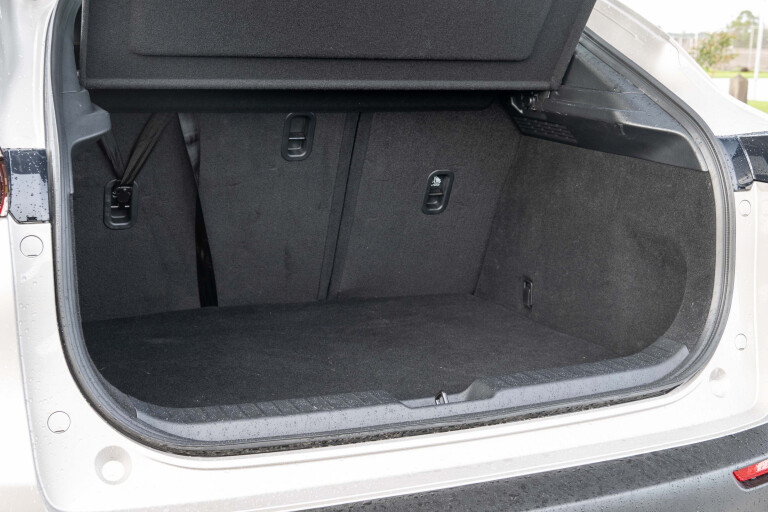
194
On the road
The 2022 Mazda CX-30 is powered by a choice of two naturally aspirated, four-cylinder petrol engines – either a 2.0-litre making 114kW of power and 200Nm of torque or a 2.5-litre good for 139kW and 252Nm. Both are mated to Mazda’s six-speed Skyactiv-Drive automatic transmission. All CX-30 variants can be had with front-wheel drive, but only the G25 Touring upwards are available with all-wheel drive.
Our test car was the 2.0-litre FWD G20e M hybrid, which was added to the range in September 2021 – the same hybrid powertrain as offered on Mazda’s electrified MX-30. This is a mild hybrid, meaning the electric motor never powers the wheels on its own as it would in a Toyota Yaris Cross hybrid.
The 2.0-litre is louder than we’d like because it’s an engine that likes to rev high (it develops peak power at 6000rpm and maximum torque at 4000rpm) but it’s only really intrusive upon cold start or under harder acceleration as it settles down to a quiet cruise. Wind and tyre noise are also pleasingly hushed.

194
While you couldn’t call it nippy, as both the accelerator (and brake) pedals need a firm and deliberate input to get much return, it’s not slow either, and thanks to some sharp steering and keen gear changes, it manoeuvres exactly where you need it to go without feeling sluggish.
It handles very well too, benefitting from being based on the Mazda 3’s underpinnings, with little to no body roll even around tighter bends – feeling nicely planted and agile which is reflective of its slender 1460kg mass. The car itself also feels quite low to the ground for an SUV, which helps it to be that bit more engaging.
The ride is befittingly smooth for a Mazda, with the suspension only proving the slightest bit fussy over the worst of surfaces, such as large potholes or particularly wince-worthy speed bumps.
It has only two selectable driving modes, default and Sport. The latter adjusts transmission response only, rather than unlocking additional performance.
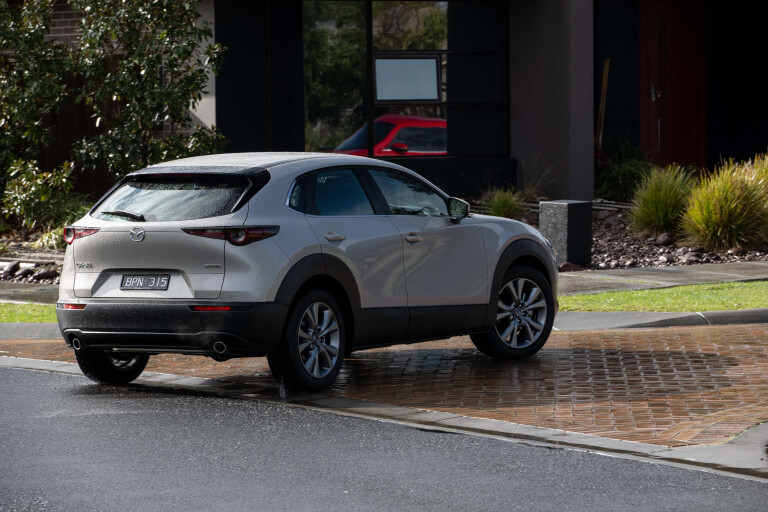
194
The transmission is quick to react to all throttle inputs and seemed to match the gear ratio well to the amount of power needed during our test, regardless of whether it was around town or on the highway.
In all, there was nothing super exciting about the drive of the CX-30, but in keeping with its inoffensive looks, it presented as a solid performer – showing skill and competency in most areas, if not being exceptional.
The Mazda’s claimed combined fuel economy is rated at 6.3L/100km and we found this to be fairly accurate during our time with the car; in fact, our average bested it at 6.1L/100km, which is not bad at all given the rising cost of petrol at the moment.
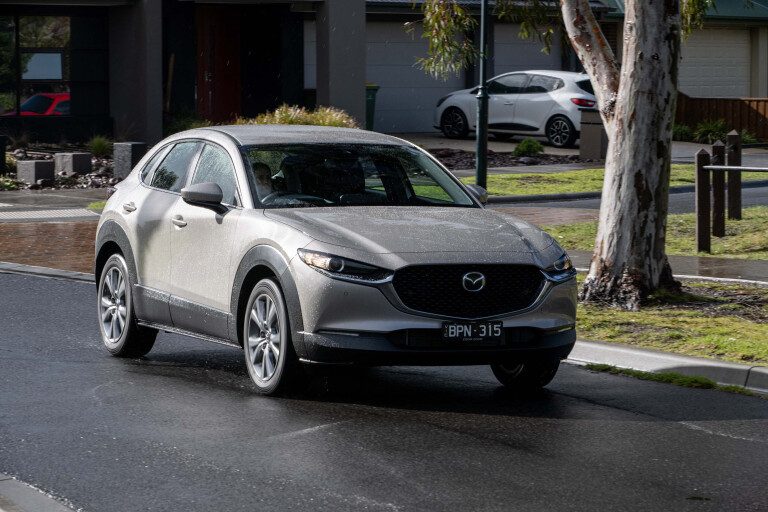
194
Ownership
Mazda Australia offers a five-year, unlimited-kilometre warranty, with five years of capped-price servicing and roadside assistance.
Pricing for servicing is as follows:
- One year/10,000km $328
- Two years/20,000km $374
- Three years/30,000km $328
- Four years/40,000km $374
- Five years/50,000km $328
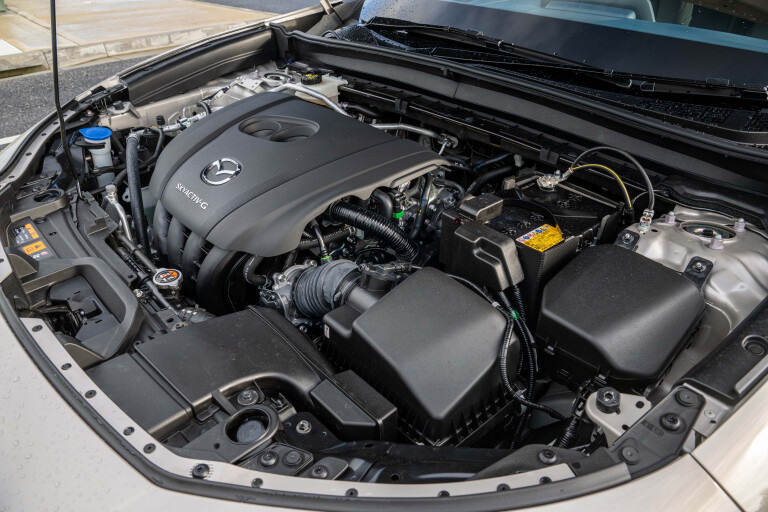
194
VERDICT
As a solid little runaround for a young singleton, or even for an older buyer with no particular need for a great deal of space, this CX-30 variant drives well, doesn’t guzzle fuel, is still on the right side of $40,000 for its size and it looks and feels premium.
But as a family car, even with just one young child, the need for more space is likely to push you up into CX-5 territory for not wildly different money. For the base model CX-5 you’re looking at around $36.5K drive-away, albeit with some small sacrifices on spec.
Space is key and the CX-30 might just need to grow up a little more to be able to work as a daily driver for families.
2022 Mazda CX-30 G20e Evolve M Hybrid Vision Tech specifications
| Body | 5-door, 5-seat small SUV |
|---|---|
| Drive | front-wheel |
| Engine | 2.0-litre 16-valve four-cylinder petrol |
| Transmission | 6-speed automatic |
| Power | 114kW @6000rpm |
| Torque | 200Nm @4000rpm |
| Bore/stroke | 83.5mm x 91.2mm |
| Compression ratio | 13:1 |
| 0-100km/h | Not quoted |
| Fuel consumption | 6.3L/100km (combined) |
| Weight | 1460kg |
| Suspension | MacPherson strut (front) / torsion beam (rear) |
| L/W/h | 4395/1795/1540mm |
| Wheelbase | 2655mm |
| Brakes | Ventilated discs (front) / solid discs (rear) |
| Tyres | 215/55 R18 |
| Wheels | 18-inch alloys |
| Price | $40,412 drive-away (VIC) |
8.0
Safety, value and features
Things we like
- Premium looks
- Comfortable ride
- Capable handling
Not so much
- Noisy, high-revving engine
- Lack of space in second row
- Relatively small boot




